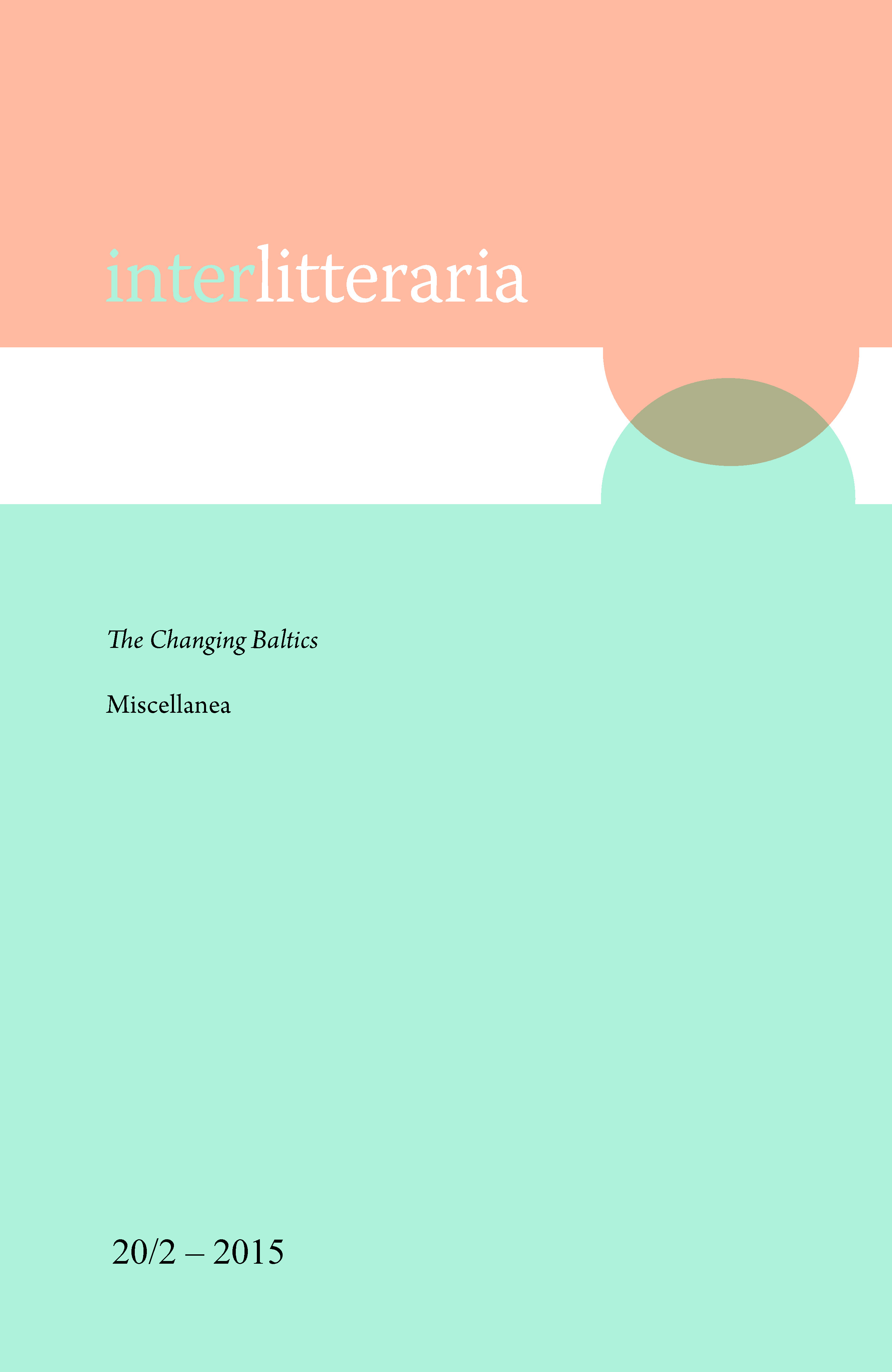Re-mediating Ophelia with Pre-Raphaelite Eyes
DOI:
https://doi.org/10.12697/IL.2015.20.2.14Keywords:
John Everett Millais, Heiner Mueller, Ophelia, Pre-Raphaelitism, Rewriting of myth, Dante Gabriel Rossetti, Elizabeth SiddalAbstract
The Shakespearean fair Ophelia has become through the centuries a multi faceted heroine apt to embody all the victims of patriarchal domination, but also the evil and victimized decadent lady, who would annihilate her tormentor. Similar oxymoronic identifications were possible partly because of the vagueness that distinguishes her character in the Shakespearean tragedy, and partly because of the fluctuating status of adolescent girls in society. Moreover, the contemporary reception of Ophelia has strongly been biased by the treatment of this literary myth by the Pre-Raphaelite Brotherhood. In the Victorian era, when issues about the condition, the power, and the rights of women were raised with particular force, Ophelia soon became an icon of sublime but dangerous beauty. Such an association even came to the point that Elizabeth Siddal – poet, painter, and model of Millais’s Ophelia – was identified with the Shakespearean heroine, by virtue of her unquenchable thirst for knowledge, her unrequited love, her prettiness, and the torture she allegedly provoked to Dante Gabriel Rossetti’s conscience.Downloads
Download data is not yet available.
References
<div class="WordSection1"><p>AJ 1852 = <em>Art-Journal</em>. “The Royal Academy”, 14.</p><p>AJ 1865 = <em>Art-Journal</em>. “Talbot and the Countess of Auvergne”.</p><p>Altick, R.D. 1985. <em>Paintings from Books: Art and Literature in Britain, 1760<strong>–</strong>1900</em>. Columbus (OH): Ohio State University Press.</p><p>Arcara, S. 2009. <em>Elizabeth Siddal. Di rivi e gigli</em>. Bari: Palomar.</p><p>Casteras, S. P. 1987. <em>Images</em><em> </em><em>of Victorian Womanhood in English Art</em>. Rutherford (NJ): Fairleigh Dickinson University Press.</p><p>Daly, G. 1989. <em>Pre</em>-<em>Raphaelites</em><em> in Love</em>. New York: Ticknor & Fields.</p><p>Dijkstra, B. 1986. <em>Idols of Perversity: Fantasies of Feminine Evil in Fin</em>-<em>de</em>-<em>Siècle</em><em> Culture</em>. New York–Oxford: Oxford University Press.</p><p>Dyer, R. 2002. <em>The Culture of Queers</em>. London–New York: Routledge.</p><p>Doughty, O. 1949. <em>A Victorian Romantic. Dante Gabriel Rossetti</em>. London: Frederick Muller.</p><p>Falchi, S. 2010. “Maddening Endurance” Post-Modern Images of Ophelia’s Madness. – <em>Shakespeare en devenir. Folie et théâtralité</em>, 3, 28.01 – <a href="http://shakespeare.edel.univ-poitiers.fr/index.php?id=161">http://shakespeare.edel.univ-poitiers.fr/index.php?id=161</a> (19.11.12).</p><p>Gellert-Lyons, B. 1977. The Iconography of Ophelia. – <em>ELH</em>, 44, 1, Spring, Baltimore (MD): The Johns Hopkins University Press, 60–74.</p><p>Gilmore, D.D. 2001. <em>Misogyny: The Male Malady</em>. Philadelphia (PA): University of Pennsylvania Press. <a href="http://dx.doi.org/10.9783/9780812200324" target="_blank">http://dx.doi.org/10.9783/9780812200324</a></p><p>Hazlitt, W. 1817. <em>Characters of Shakespeare’s Plays</em>. London: C.H. Reynell.</p><p>Hillman, J. 1989. <em>A Blue Fire: Selected Writings</em>. T. Moore, ed., New York: Harper Perennial.</p><p>Holman-Hunt, W. 1914. <em>Pre-Raphaelitism</em><em> and the </em><em>Pre-Raphaelite</em><em> Brotherhood</em>. Second Edition, vol. 1, New York: E.P. Dutton and Company.</p><p>Jameson, A. 1904 [1832]. <em>Shakespeare’s Heroines: Characteristics of Women Moral Poetical & Historical</em>. London: Dent.</p><p>Johnson, S. 1765. Notes. – W. Shakespeare, <em>The Plays of William Shakespeare in Eight Volumes: With the Corrections and Illustrations of Various Commentators; to Which Are Added Notes by Sam Johnson</em>. Vol. 8, London: J. and R. Tonson.</p><p>Knowles, R. 2003 [1998]. “The Real of It Would Be Awful:” Representing the Real Ophelia in Canada. <em>– Shakespeare and Canada: Essays on Production, Translation, and Adaptation</em>. Brussels: Peter Lang, 117–136 [<em>Theatre</em><em> Survey</em>, 39, 1, May 1998, 21–40].</p><p>Laing, R.D. 1960. <em>The</em><em> </em><em>Divided</em><em> </em><em>Self:</em><em> </em><em>A Study of Sanity and Madness</em>. London: Tavistock Publications.</p><p>MacDougall, J. 1988. Le Festival de Théâtre des Amériques. Montreal 1987. – <em>TDR</em>, 32, 1, Spring, 9–19.</p><p>Müller, H. 1995 [1977]. The Hamletmachine. – M. von Henning, ed. and trans., <em>Theatremachine</em>. London: Faber and Faber, 87–94.</p><p>Nochlin, L. 1989 [1988]. <em>Women, Art, and Power and Other Essays</em>. London: Thames and Hudson.</p></div><p>Pipher, M. 1994. <em>Reviving</em><em> </em><em>Ophelia:</em><em> </em><em>Saving</em><em> </em><em>the</em><em> </em><em>Selves</em><em> </em><em>of Adolescent Girls</em>. New York: Putnam.</p><p>Rhodes, K. 2008. <em>Ophelia</em><em> </em><em>and</em><em> </em><em>Victorian</em><em> </em><em>Visual</em><em> </em><em>Culture:</em><em> </em><em>Representing</em><em> </em><em>Body</em><em> </em><em>Politics</em><em> </em><em>in</em><em> </em><em>the</em><em> </em><em>Nineteenth</em><em> Century</em>. Aldershot: Ashgate.</p><p>Rimbaud, A. 1895. Ophélie [1870]. – <em>Poésies Complètes. Avec préface de Paul Verlaine</em>. Paris: Leon Vanier, 62–64.</p><p>Rambo Ronai, C., Zsembik, B.A., Feagin J.R. 2014. <em>Everyday</em><em> </em><em>Sexism</em><em> </em><em>in</em><em> </em><em>the</em><em> </em><em>Third</em><em> </em><em>Millennium</em>. New York–London: Routledge.</p><p>Rossetti, D. G. 2002–2010. <em>The</em><em> </em><em>Correspondence</em><em> </em><em>of Dante Gabriel Rossetti</em>. W.E. Fredeman, ed., vol. 2, Woodbridge: D.S. Brewer.</p><p>Showalter, E. 1985. Representing Ophelia: Women, Madness, and the Responsibilities of Feminist Criticism. – P. Parker, G. Hartman, eds., <em>Shakespeare and the Question of Theory</em>. New York–London: Methuen.</p><p>Solomon Kiefer, C. 2001. <em>The Myth and Madness of Ophelia</em>. – Amherst (MA): Mead Art Museum–Amherst College.</p><p>Sonstroem, D. 1970. <em>Rossetti and the Fair Lady</em>. Middletown (CT): Wesleyan University Press.</p><p>Stephens, F. G. 1894. <em>The Athenaeum</em>, 12 May, cit. in Trippi (2004: 135).</p><p>TA 1852 = <em>The Athenaeum</em>. “Fine Arts – the Royal Academy”, 25.</p><p>Teraoka, A. A. 1985. <em>The Silence of Entropy or Universal Discourse: The Postmodernist Poetics of Heiner Müller</em>, New York–Berne–Frankfurt am Main: Peter Lang.</p><p>Trippi, P. 2004. <em>J.W. Waterhouse</em>. London: Phaidon.</p>Wandor, M. 1981. <em>Understudies: Theatre and Sexual Politics</em>. London: Eyre Methuen.
Downloads
Published
2015-12-31
Issue
Section
Articles
License
The contents of Interlitteraria are published under CC BY-NC-ND licence.


